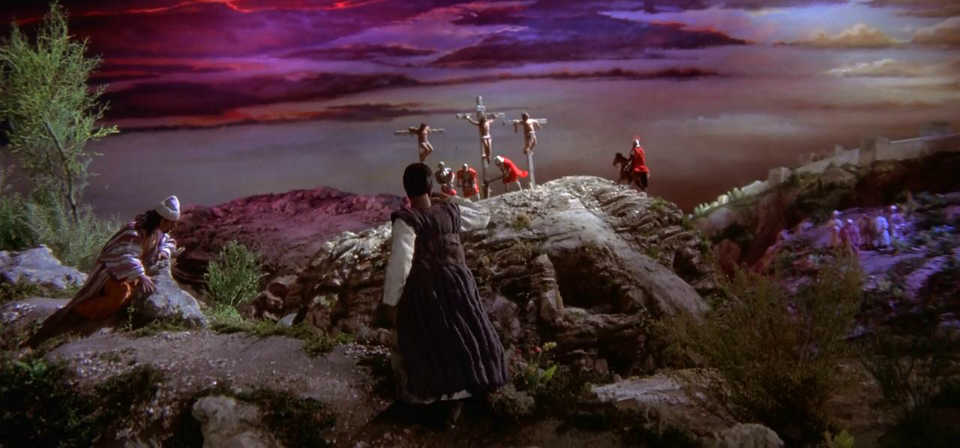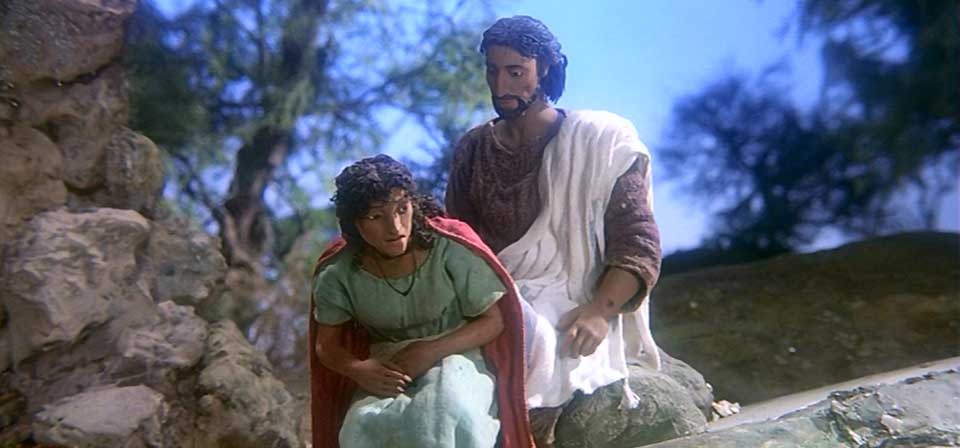A Triduum ritual: The Miracle Maker
Why an animated Jesus movie has been a fixed part of my family’s Triduum celebration for over two decades
Every year, my family observes a cinematic ritual for Triduum.
Our seasonal movie-watching during Advent, Lent, and the Christmas and Easter seasons varies from year to year, but Triduum is always the same.
On Holy Thursday, just before the Mass of the Lord’s Supper and the start of Triduum, we watch the first 39 minutes of the animated Jesus movie The Miracle Maker, from the start of Jesus’ ministry to the raising of Jairus’ daughter and the execution of John the Baptist.
On Good Friday, after the Celebration of the Lord’s Passion, we watch the next 36 minutes: essentially the Passion narrative to Jesus’ burial, ending with Mary Magdalene weeping at the foot of the cross and running despondently through the streets.
Perhaps we ought to save the last eight or nine minutes — the Resurrection — until Sunday afternoon, but we don’t. We watch it on Holy Saturday evening in anticipation of the Easter Vigil. (After Sunday Mass we visit family.)
Our adult children have grown up with this movie. Our second daughter, now 17, recently remarked on the role it had played in her spiritual formation. Every year I’m grateful that this film came along at the right time to play this role in our domestic life.
Watching The Miracle Maker, I find year after year that a plasticine stop-motion puppet — voiced with warmth, humor and authority by Ralph Fiennes — persuasively is Jesus to me, as the crucifix over my bed or the Divine Mercy image on my wall is Jesus, in a way that no actor could achieve.
Because it’s animation, many people assume The Miracle Maker is a kids’ movie. This is only half accurate. (I’ve called it must-see Easter season viewing for absolutely everybody, and I stand by that.)
Yes, it’s simple enough to be accessible to children. Yet no other Jesus movie I’ve seen is so well-grounded in the historical, cultural, political, religious, and even economic realities of Jesus’ day, or in the religious conflict between Jesus and the Jewish authorities.
From Jewish-Roman tensions to diverse groups within Judaism — Pharisees, Sadducees, and Zealots; priests and local religious leaders, working-class Jews, despised tax collectors and other “sinners,” hated Samaritans, and even more marginal figures like “Mad Mary” Magdalene — Murray Watts’ astonishingly deft screenplay efficiently sketches the lines between all these groups.
And then it demonstrates how easily Jesus crosses those lines, to the discomfort of all around him, his disciples included.
For instance, when Simon the Pharisee (Alfred Molina) invites Jesus to dine with him, we see the working-class disciples’ unease amid such posh surroundings as well as the Pharisees trying to needle Jesus about his habit of dining “in another part of town.”
And while the Pharisees express indignation that Jesus allows the exorcised Mary Magdalene (Miranda Richardson) to weep over his feet and dry her tears with her hair, the disciples also are scandalized when Jesus invites a hated tax collector, Matthew, to join their ranks.
Even the children surrounding Jesus are startled when he makes a Samaritan the hero of one of his parables, and a boy bursts out, “Samaritans throw rocks at us! I hate them, I spit on them!”
The Miracle Maker excels, where so many other Jesus films fail, at capturing the sense of surprise and revelation around Jesus and his words.
At the Last Supper, when Jesus pronounces the words of institution over the bread, Thomas murmurs incredulously, “Your body ?!” And Jesus’ strange words about not drinking wine with them again until drinking it new in the kingdom of heaven elicit understandable consternation from Peter.
A low-key moment on the walk to Gethsemane, as Jesus declines an invitation to sit with two disciples, Cleopas and Jairus, and answer their questions, has become more important to me over the years.
Jesus has begun to be in distress, but he turns down the invitation gently, promising to come to them later (thus foreshadowing the Emmaus road resurrection appearance).
Young Tamar — Jairus’ daughter, whom Jesus raised from the dead, and whose point of view throughout the film is an important key to its fresh take on the Gospel story — is anxious over his distress. Still troubled, Jesus speaks comfortingly to her of the many rooms in his Father’s house, and of the special place he will prepare for her.
Although The Miracle Maker omits all but the last of Jesus’ rousing the sleeping disciples in the garden, this emotional exchange with Cleopas, Jairus, and Tamar speaks eloquently to me of the loneliness of Jesus on the eve of his Passion: of the enormous burden he carried that he could share with no one else, even in seeking comfort and support.
Just as animation excels at highlighting the power of Jesus’ parables, so it can take us into Jesus’ agony in the garden of Gethsemane in ways beyond what live action can do. (The film blends two animation techniques: stop motion for “objective,” outward reality, and hand-drawn cel animation for “subjective,” inner experiences, memories, imagination, etc.)
We see the dread cup Jesus must drink — along with Satan, and the garden itself, inviting him to flee, to escape his fate. Fiennes’ impassioned performance of Jesus’ prayer in agony, from his horror at what he must undergo to his abject surrender to his Father’s will, is overwhelming in its emotional power.
As afflicted as he is the garden, Jesus is serene and muted in his trials before Caiaphas (David Schofield), Pontius Pilate (Ian Holm, brilliant as always), and Herod (Anton Lesser).
To Pilate’s question “Are you the king of the Jews?” Jesus’ quiet answer — “These are your words” — aptly gives the sense of the biblical “You say so.”
From the despair of Judas to the self-recrimination of Joseph of Arimathea (who bitterly regrets being cowed at the Sanhedrin and not saying more to try to save Jesus) to the desperate panic of Mary Magdalene (who fears her demons may return), the film powerfully depicts the sense of the light going out of the world at Jesus’ death and burial.
There is one counterpoint: At the moment of Jesus’ death, the camera swoops into the Temple for a momentous glimpse of the rending of the Temple veil — immediately followed by a powerful downward pan from the top of the cross to the dead Christ on the cross and Mary Magdalene and the mother of Jesus at its foot.
“It’s true,” whispers the Roman tribune, an African named Quintilus (Lennie James), who has also witnessed Jesus’ triumphal entry into Jerusalem and the controversy over paying taxes to Caesar during the disturbance in the Temple. “It must be true. This man was a son of God!”
I’ve heard that line in so many movies, but I never believe it (that is, believe that the Roman soldier believes it) as much as I do here.
Although the Resurrection sequence is less than 10 minutes, I know no other Jesus film that better captures the exhilarating spirit, or the strangeness, of the Resurrection narratives.
Two episodes — Jesus’ appearance to Mary Magdalene (done in objective stop-motion) and his encounter with Cleopas and Jairus on the Emmaus road (recounted in subjective cel-animation memory) — handle the mysterious unrecognizability of the risen Jesus with unparalleled grace.
When Jesus approaches the weeping Mary Magdalene, her back is to him, and the shot is composed of Jesus’ head out of frame, making him semi-anonymous to the viewer. “Sir, if you’re the gardener…” she begins, making explicit her confusion. (Compare to the cringey treatment in the generally decent 2003 The Gospel of John, with Jesus hiding his face behind plants as though trying to pass for a gardener.)
Then Jesus sits down, and we see his face moments before Mary does. When she finally turns to look at him, a point-of-view shot shows his face slowly coming into focus as her eyes are opened and she realizes the light has come back into the world.
The Emmaus road appearance works in part by relying on subjective cel animation as Cleopas and Jairus breathlessly relate their experience.
This occurs in the exceptionally well-constructed penultimate sequence, in which Jesus appears to Thomas. (All of these appearances are conflated to Easter Sunday.)
This sequence begins with Thomas’ incredulous response to Peter and John’s exuberant account of meeting Jesus after discovering the empty tomb.
Disbelief grows into irritation as Cleopas and Jairus burst in (literally knocking Thomas down) with news of their encounter. (Jesus’ identity is hidden from Cleopas and Jairus partly by a sudrah or head covering and partly by the light of the sun in their eyes, a conceit that cel animation sells better than stop motion would have. The moment of revelation, in which Jesus is made known in the breaking of the bread, is powerfully connected to the Last Supper account.)
Finally Thomas’ exasperation boils over. In the crowning moment of the sequence’s low-key humor, in the middle of his tirade about putting his fingers into the nail marks in Jesus’ hands, Thomas momentarily takes the voice of Jesus addressing him for one of the other disciples — and then realizes his mistake. “My Lord and my God!”
“Yes … you believe because you’ve seen me, Thomas. But even happier are those who will believe without ever seeing me at all.” As he speaks these words, Jesus looks straight into the camera.
His words are addressed to the audience. He’s speaking to all who believe.
He’s speaking to me.
Related

Must-see Easter season viewing: The Jesus movie for absolutely everyone
The Miracle Maker is a singular achievement: a Jesus movie that is simple enough for children, sophisticated enough for scripture scholars and theologians, and artful enough for discerning cinephiles.

The Miracle Maker (2000)
Fiennes sounds like a man improvising a public speech as he delivers long-familiar words about the house on the rock or the parable of the mustard seed. His Jesus is attractive, composed, commanding, and compassionate; he can rise to righteous anger (as at the cleansing of the temple), but has an acute sense of humor (seen particularly in satirical parables such as the log in the eye).
Recent
- Benoit Blanc goes to church: Mysteries and faith in Wake Up Dead Man
- Are there too many Jesus movies?
- Antidote to the digital revolution: Carlo Acutis: Roadmap to Reality
- “Not I, But God”: Interview with Carlo Acutis: Roadmap to Reality director Tim Moriarty
- Gunn’s Superman is silly and sincere, and that’s good. It could be smarter.
Home Video
Copyright © 2000– Steven D. Greydanus. All rights reserved.